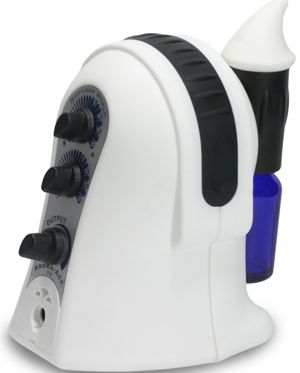- Home
- Guide for Essential Oil Use
- Aromatherapy Diffusers
As an affiliate with Amazon, Bookshop, and other programs, I may earn revenue from qualifying purchases through affiliate links. This does not affect the price you pay. Privacy Policy / Disclosures. This site is for educational purposes only.
Search this site:
Types of Aromatherapy Diffusers for Home Use
An aromatherapy diffuser is any device that disperses the scent of essential oils into the air. The best essential oil diffuser for you depends on how you plan to use it, what effects you want to achieve, and your budget. Understanding the types of aromatherapy diffusers will help you make an informed choice.
For example, some diffusers for essential oils produce a strong dispersion that's effective in large rooms, while others are best suited for small spaces. Some diffusers use heat, although some sources believe that heat may change certain components of essential oils, reducing their therapeutic benefit. The cost of an essential oils diffuser ranges from less than $10 to several hundred dollars.
Diffusers can be made of plastic, wood, glass, ceramic, or other materials.
Types of Aromatherapy Diffusers
This essential oil diffuser guide covers these types of aromatherapy diffusers:
- Nebulizers/Atomizers
- Ultrasonic Diffusers
- Oil Burners/Warmers
- Fan Diffusers
- Terra Cotta Diffusers
- Personal Diffusers
Essential Oil Nebulizer or Atomizer
A nebulizing diffuser, sometimes called an atomizing diffuser, pumps air through a chamber filled with essential oils. An aromatherapy nebulizer uses no heat and no water, and converts essential oil into microscopic droplets that stay in the air for a long time.
Nebulizers or atomizers produce the strongest aroma and effectively distribute essential oils into the air while maintaining their therapeutic properties. These essential oil diffusers are the best choice for therapeutic purposes because the diffusion process releases small particles that your lungs and body can absorb rapidly. These diffusers are also usually the most expensive option.
Ultrasonic Aromatherapy Diffusers
Cold air diffusers atomize a mixture of cold water and essential oils, breaking up molecules into a microscopic mist. Many cold air diffusers use ultrasonic technology to create a high frequency that atomizes the water and oils. These aromatherapy machines also maintain the therapeutic value of essential oils.
Essential Oil Burners or Warmers
Aromatherapy oil burners or oil warmers use either candles or electricity to create heat that sends the scent of essential oils into the air. Just remember that some sources believe heating essential oils diminishes their therapeutic properties.
Candle diffusers are popular and can add ambience to a room.
Electric oil burners offer the safety advantage of no flame and also come in many decorative types.
A similar aromatherapy diffuser is a lamp ring. The ring, which might be metal, ceramic, or terra cotta, has a grooved lip that sits directly onto a light bulb. The lip holds essential oil, and the heat from the light bulb heats the oil, dispersing it into the room.
Aromatherapy Fan Diffusers
A fan diffuser is efficient and easy-to-use. A small fan blows air through a pad containing essential oils. Fan diffusers are usually low cost and lightweight, making them useful for travel. They don't use a lot of essential oil. The aroma has limited reach, so this type of essential oil diffuser is best suited to small spaces.
Terra Cotta and Reed Diffusers
Terra cotta diffusers come in the form of aromatherapy pendants you can wear, as well as in the form of tabletop terra cotta pieces. The porous surface of terra cotta releases the scent of essential oil into the air.
A reed diffuser is more of an air freshener than a true diffuser. Reeds placed in a bottle or jar of scented oil absorb the oil and release it into the air.
Personal Aromatherapy Diffusers
A personal aromatherapy diffuser is small and portable, giving you the benefits of essential oil diffusion anywhere without disturbing other people. Personal diffusers include:
- An aromatherapy necklace contains a small pad. You drop essential oils onto the pad, wear the necklace, and enjoy the scent throughout the day.
- A handheld diffuser is convenient anywhere.
- A car diffuser for travel.





